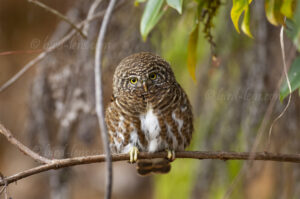 Driving in the Himalayas. Our driver is a real expert. Right next to the roadside of the well-known Mandala Road in Arunachal Pradesh, only about 10m away, a little owl is sitting on a bamboo bush. A heated discussion ensues. Eventually the owl turns out to be a Collared Owlet (Taenioptynx brodiei). This small owl is most easily distinguished from the larger, mostly sympatric Asian Barred Owlet (Glaucidium cuculoides) by its mottled rather than striped forehead and – if the back of the head is visible – by the wrong facial pattern, which attacks from behind should fend off. Great, the owl is still sitting on a branch a little further up from us for a while. The bird activity with Stripe-throated Yuhina (Yuhina gularis) and Whiskered Yuhina (Yuhina flavicollis) in the adjacent tree does not seem to be affected as the owl does not sing. Only when I start to whistle the owls’ song do the birds react very allergically. The pygmy owl then flies away. The songbirds don’t come any closer, though.
Driving in the Himalayas. Our driver is a real expert. Right next to the roadside of the well-known Mandala Road in Arunachal Pradesh, only about 10m away, a little owl is sitting on a bamboo bush. A heated discussion ensues. Eventually the owl turns out to be a Collared Owlet (Taenioptynx brodiei). This small owl is most easily distinguished from the larger, mostly sympatric Asian Barred Owlet (Glaucidium cuculoides) by its mottled rather than striped forehead and – if the back of the head is visible – by the wrong facial pattern, which attacks from behind should fend off. Great, the owl is still sitting on a branch a little further up from us for a while. The bird activity with Stripe-throated Yuhina (Yuhina gularis) and Whiskered Yuhina (Yuhina flavicollis) in the adjacent tree does not seem to be affected as the owl does not sing. Only when I start to whistle the owls’ song do the birds react very allergically. The pygmy owl then flies away. The songbirds don’t come any closer, though.
A familiar experience. Thus, even in northern climes in the winter twilight, the monotonous, bright call of a Eurasian Pygmy-Owl or Northern Pygmy Owl (Glaucidium passerinum) can suddenly be heard in monotonous silence. When it gets colder again in the twilight, a second caller might even come up. A second male feels addressed and also calls, but in a different pitch. First, the second caller can be heard from a distance. But this Pygmy Owl feels provoked, flies fluttering along the forest path and finally sits right next to its rival. This applies in particular if the location is in the area of the territory boundary of two males.
At one point I observed that this encounter was apparently so shocking that both Pygmy Owls remained silent afterwards. The rival then flew away again. His flight silhouette was beautiful to see against the evening, cloudless sky. The flight even has something in common with that of a bat.
A diminutive owl is the Collared Owlet, which often sings its distinctive tut-tut song during the day, when its status as “small mountain forest birds’ greatest enemy” is confirmed by bullying them. The Collared Owlet takes on a large number of small prey, especially birds, but also insects and rodents. In relation to the size of the owls – as with the Northern Pygmy Owl – quite large birds are caught, including adult ones. Examples are breeding Barbets (Capitonidae), Woodpeckers (Picidae) and Thrushes (Turdidae). The Collared Owlet does not disdain nestlings either.
The Collared Owlet hunts from fence posts and other lookouts at all times of the day; making it one of the most diurnal members of the owl family. When hunting, the Collared Owlet swoops down from his perch to catch insects in flight, among other things. It holds onto larger prey with its foot while it yanks at it with its beak. The male’s territorial and territorial song is a soft whistle, huh-huh-huh or huh-huh-huh video, the second and third notes closer together and the phrases repeated at short intervals; mostly 3-4 series in a row. While singing, the male turns his head in all directions, which gives a very special effect of ubiquity.
In order to cope with the growing demand for top images of the rarer species of the Palearctic, Bird-lens.com endeavors to further expand the range of images of birds in the Western Palearctic. Trips to nearby and remote locations to snap pictures of rare birds of the Western Palearctic have been very successful. The image of proof on the blog is just a first impression, which you can find very soon in the gallery in the “Picture Shop“. Just leave a message if bird-lens.com can serve with a picture.